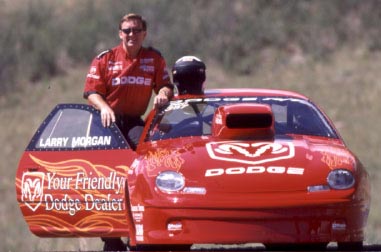|
One thing is sure, the new hemi is a serious engine. Larry Morgan told
DRO a year ago, "This new hemi cylinder head flows better than any head
I've ever flowed."

Larry has had a lot of heads on the ol' Superflo bench so you would
have to believe him. He also told DRO, "This engine is going to make
a lot of power!" Obviously Morgan knew what he was talking about.
Factory Pro Stock team owner David Nickens has said that the new hemi
really starts to make a lot horsepower when it revs over 9500 rpm. It
is reported that the Avenger body that the Mopar factory teams had been
running just wouldn't allow the hemi to get to the rpm range where it
would make a lot of power.
Mopar engineers probably knew that in order to take advantage of the
power their new hemi engine was making they would need a new body that
would be competitive aerodynamically with the sleek Pontiac Grand Am
and Chevrolet Cavalier.
The engineers started looking for a Mopar body some time in 1999 that
they could re-engineer into a Pro Stocker and eventually settled on
the Neon. Unfortunately, at that time the Neon was only available in
a four-door model. The last two-door Neon had rolled off of the DaimlerChrysler
assembly line in '98.
Fortunately, NHRA has a rule that allows racers to use bodies up to
five model years old in Pro Stock. Remember how long the Coughlins ran
their '96 Olds Cutlass because it was so aerodynamically clean? The
'98 two-door Neon will be legal for NHRA competition until at least
2003.
Once the decision was made to use the Neon body style the engineers
at DaimlerChrysler got together with Rick Jones of RJ Race Cars. Jones'
shop has been building the Dodge Pro Stock cars for several years and
it was decided that his shop would build the "factory hot rod" Neons.
The project was actually started sometime in 1999 and it has taken
Jones and Mopar has nearly two years of serious research, development
and manufacturing to get to get the first Neons to the track.
According to Rick Jones, building the Neon took him and the Mopar engineers
two years and six trips to the Lockheed wind tunnel at Atlanta (which
by the way, is the same wind tunnel that many of the NASCAR teams use).
Jones not only worked with the factory engineers but he also had to
satisfy the NHRA tech department.
"We had NHRA tech guys looking at the body every step of the way. They
had to approve everything we did," Jones said. "We ended up with a body
that had a low co-efficient of drag, a smaller frontal area and that
had some down force on both the front and back part of the body."
|